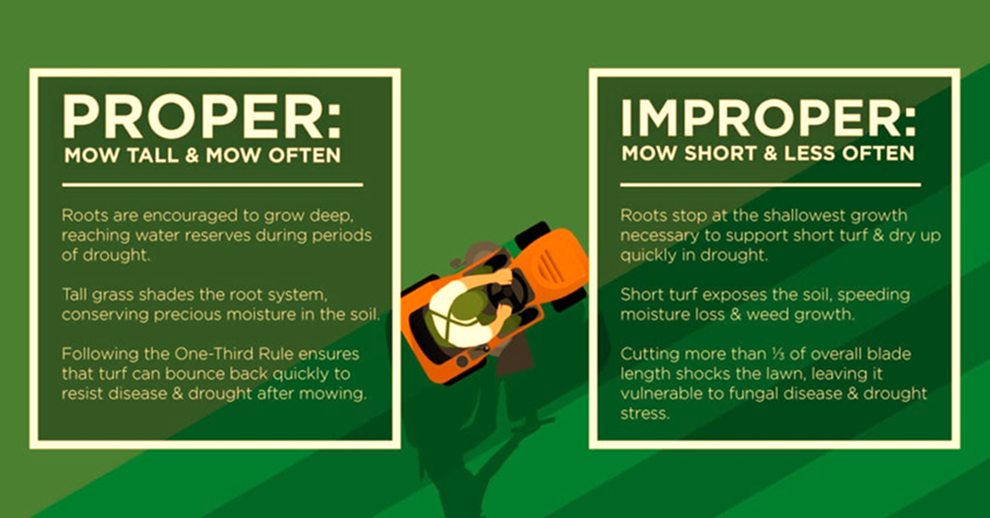Mowing Tips and Recommendations for Yards
How To Mow Your Lawn
If your goal is a thick, beautiful lawn that blocks out weeds and stands strong against disease. Mow tall and mow often. Spend time maintaining and mowing properly and you’ll spend less time fixing the issues that come along with taking shortcuts.
Recommended Mowing Height
The ideal mowing height for most lawns is between 3.5 to 4 inches. The benefits of mowing tall are numerous. Roots will grow deeper, improving drought tolerance. Tall turf provides better shade for the root system, conserving water, and blocking the growth of unwanted weeds. A longer grass blade provides more area for your lawn’s critical process of photosynthesis.
Recommended Mowing Frequency
Maintaining a proper frequency will help ensure that no more than 1/3 of the total grass blade is removed at one time. This is referred to as the One-Third Rule. Cutting off more than 1/3 of the overall blade causes stress on the plant and weakens your lawn’s defenses. Mowing correctly and maintaining the One-Third Rule will also save you from needing to bag your lawn clippings which is a great source of nutrients for your lawn.
Stay Sharp
Mowing with a sharp blade ensures a clean cut. Grass with ragged edges from a dull cut is more susceptible to disease and water loss. Sharpen your mower blades often. Preferable at least once in the spring and once in the fall.
Switch It Up
Switch up your direction with each cutting to encourage grass blades to stand straight. To minimize extra turns and backtracking, mow your lawn in rows.

Learn More about the One-Third Rule from Cale Bigelow, Professor of Agronomy in the Turf Science Program at Purdue University. Get a Quote Today
Safety First
Before you mow, take a walk through the yard to collect debris that may be thrown by the blade. These objects could be propelled causing serious bodily injury to you or anyone nearby (objects may also damage your mower or dull the mowing blade).
Stay Cool
Choose the coolest time of day possible (morning or evening) to minimize heat stress for both you and your turf.
Stay Dry
Mowing wet grass can get messy, but it also poses some soil and safety concerns as well. Don’t risk slipping on wet turf with the mower running. Additionally, the weight of the mower can cause soil compaction when it’s soggy, and wet grass is more resistant to the mower blade. The best bet is to allow the turf to dry sufficiently before you begin mowing.
Commonly Asked Questions
Q: How often should I sharpen my mower blades?
A: Mowing with a sharp blade ensures a clean cut. Grass with ragged edges from a dull cut is more susceptible to disease and water loss. Sharpen your mower blades often. Preferable at least once in the spring and once in the fall.
Q: Should I mow in a pattern?
A: Switch up your direction with each cutting to encourage grass blades to stand straight. To minimize extra turns and backtracking, mow your lawn in rows.
Q: What is the best time of the day to mow the grass?
A: Choose the coolest time of day possible (morning or evening) to minimize heat stress for both you and your turf.
Q: Should I mow the grass when it is wet?
A: Mowing wet grass can get messy, but it also poses some soil and safety concerns as well. Don’t risk slipping on wet turf with the mower running. Additionally, the weight of the mower can cause soil compaction when it’s soggy, and wet grass is more resistant to the mower blade. The best bet is to allow the turf to dry sufficiently before you begin mowing.
Need additional help? The experts at Lawn Pride are here to answers all your questions. Call us at 317-251-6800